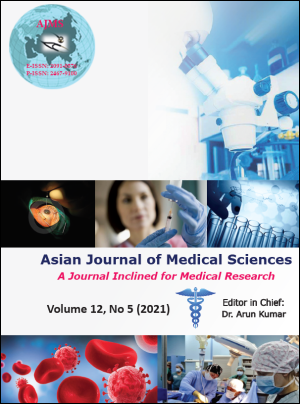A study of serum phosphate levels and its correlation with curb-65 score in community acquired pneumonia
Keywords:
Community acquired pneumonia, CURB65, Hypophosphatemia, Hyperphosphatemia, COPDAbstract
Background: Community acquired pneumonia (CAP) refers to pneumonia contracted by a person with little or no contact with health care system. Phosphorus is an essential molecule in ATP, playing a central role in energy production. A normal range is 2.5 to 4.5 mg/dl. Phosphate disturbance are noted in patients with pneumonia. Hypophosphatemia, plays a role in impairing chemotaxis, phagocytosis and bactericidal activity of macrophages. Hyperphosphatemia in pneumonia result in hypocalcaemia and pulmonary calcification. Hence study of serum phosphate levels in community acquired pneumonia is of clinical significance.
Aims and Objective: The was aimed to estimate the levels of serum phosphate in patients with community acquired pneumonia and to correlate serum phosphate levels with CURB 65 severity score.
Materials and Methods: Seventy-five CAP patients admitted as inpatients are included in this study. Chest X ray is obtained in all suspected cases. Serum phosphate levels are determined through blood investigation on Day 1 and Day 3.
Results: Serum phosphate levels on Day 1 and Day 3 were significantly associated with CURB65 score. Both high and low phosphate levels were associated with high CURB 65 score. The association between phosphate levels and CURB 65 score was significant in patients who got discharged but not in patients who expired.
Conclusions: Present study of serum phosphate levels as biomarkers in CAP showed that both hypophosphatemia and hyperphosphatemia carried poor prognosis which correlated with high CURB65 score.
Downloads
Downloads
Published
How to Cite
Issue
Section
License
Authors who publish with this journal agree to the following terms:
- The journal holds copyright and publishes the work under a Creative Commons CC-BY-NC license that permits use, distribution and reprduction in any medium, provided the original work is properly cited and is not used for commercial purposes. The journal should be recognised as the original publisher of this work.
- Authors are able to enter into separate, additional contractual arrangements for the non-exclusive distribution of the journal's published version of the work (e.g., post it to an institutional repository or publish it in a book), with an acknowledgement of its initial publication in this journal.
- Authors are permitted and encouraged to post their work online (e.g., in institutional repositories or on their website) prior to and during the submission process, as it can lead to productive exchanges, as well as earlier and greater citation of published work (See The Effect of Open Access).




